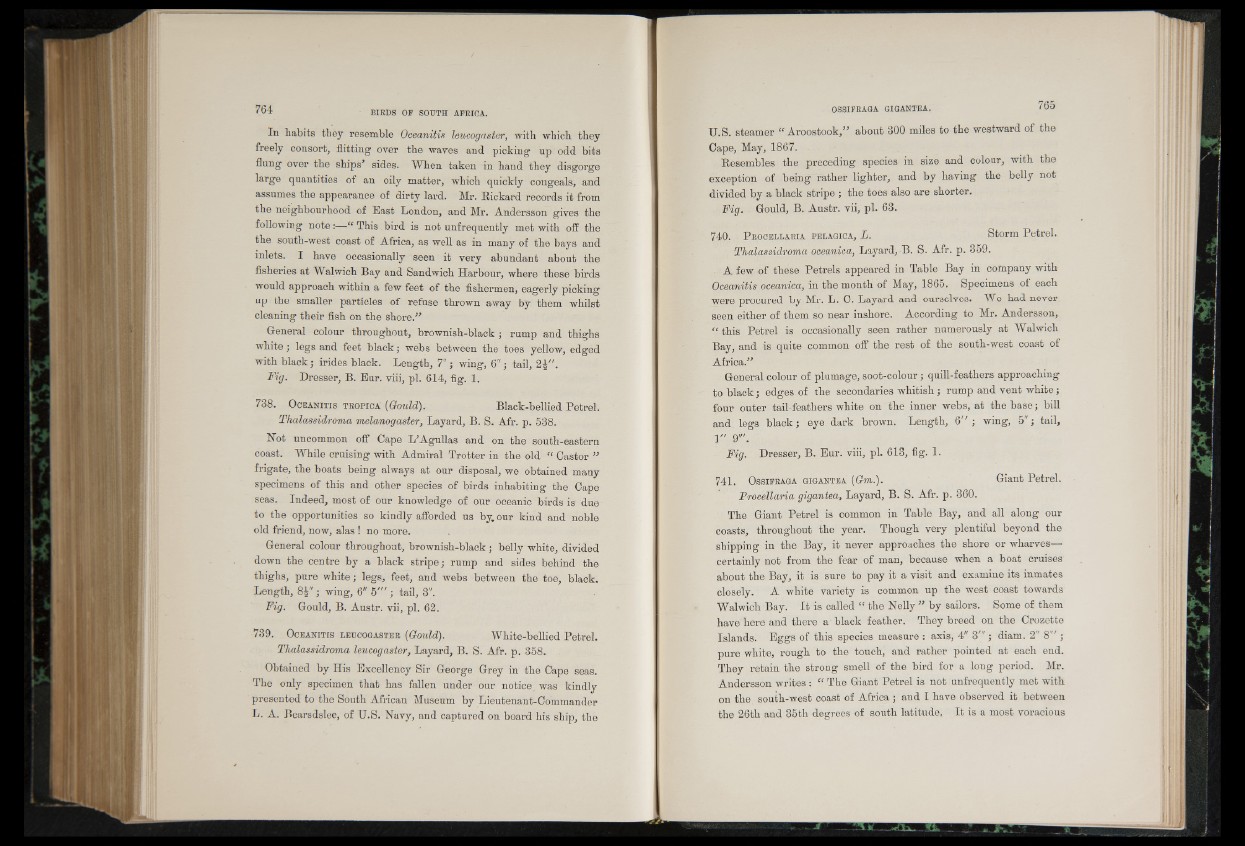
In habits they resemble Oceanitis leucogaster, with which they
freely consort, flitting over the waves and picking up odd bits
flung over the ships* sides. When taken in hand they disgorge
large quantities of an oily matter, which quickly congeals, and
assumes the appearance of dirty lard. Mr. Rickard records it from
the neighbourhood of East London, and Mr. Andersson gives the
following note:—“ This bird is not unfrequently met with off the
the south-west coast of Africa, as well as in many of the bays and
inlets. I have occasionally seen it very abundant about the
fisheries at Walwich Bay and Sandwich Harbour, where these birds
would approach within a few feet of the fishermen, eagerly picking
up the smaller particles of refuse thrown away by them whilst
cleaning their fish on the shore.**
General colour throughout, brownish-black ; rump and thighs
white; legs and feet black; webs between the toes yellow, edged
with black; irides black. Length, 7" ; wing, 6"; tail, 2£".
Fig. Dresser, B. Ear. viii, pi. 614, fig. 1.
738. O c ea n it is TROPICA (Gould). Black-bellied Petrel.
Thalassidroma melanogaster, Layard, B. S. Afr. p. 538.
Not uncommon off Cape L’Agullas and on the south-eastern
coast. While cruising with Admiral Trotter in the old “ Castor **
frigate, the boats being always at our disposal, we obtained many
specimens of this and other species of birds inhabiting the Cape
seas. Indeed, most of our knowledge of our oceanic birds is due
to the opportunities so kindly afforded us by. our kind and noble
old friend, now, alas ! no more. i
General colour throughout, brownish-black; belly white, divided
down the centre by a black stripe; rump and sides behind the
thighs, pure white; legs, feet, and webs between the toe, black.
Length, 8 |" ; wing, 6" 5"' ; tail, 3".
Fig. Gould, B. Austr. vii, pi. 62.
739. Ocea n it is leucogaster (Gould). White-bellied Petrel.
Thalassidroma leucogaster, Layard, B. S. Afr. p. 358.
Obtained by His Excellency Sir George Grey in the Cape seas.
The only specimen that has fallen under our notice was kindly
presented to the South African Museum by Lieutenant-Commander
L. A. Bearsdslee, of U.S. Navy, and captured on board his ship, the
U.S. steamer ‘‘ Aroostook,** about 300 miles to the westward of the
Cape, May, 1867.
Resembles the preceding species in size and colour, with the
exception of being rather lighter, and by having the belly not
divided by a black stripe ; the toes also are shorter.
Fig. Gould, B. Austr. vii, pi. 63.
740. • P rocellaria pelagica, L. Storm Petrel.
Thalassidroma oceanica, Layard, B. S. Afr. p. 359.
A few of these Petrels appeared in Table Bay in company with
Oceanitis oceanica, in the month of May, 1865. Specimens of each
were procured by Mr. L. C. Layard and ourselves. We had never
seen either of them so near inshore. According to Mr. Andersson,
“ this Petrel is occasionally seen rather numerously at Walwich
Bay, and is quite common off the rest of the south-west coast of
Africa.**
General colour of plumage, soot-colour; quill-feathers approaching
to black; edges of the secondaries whitish ; rump and vent white;
four outer tail-feathers white on the inner webs, at the base; bill
and legs black; eye dark brown. Length, 6" ; wing, 5"; tail,
1" 9'".
Fig. Dresser, B. Eur. viii, pi. 613, fig. 1.
741. O ssifraga gig ante a (Gm.). Giant Petrel.
Procellaria gigantea, Layard, B. S. Afr. p. 360.
The Giant Petrel is common in Table Bay, and all along our
coasts, throughout the year. Though very plentiful beyond the
shipping in the Bay, it never approaches the shore or wharves—
certainly not from the fear of man, because when a boat cruises
about the Bay, it is sure to pay it a visit and examine its inmates
closely. A white variety is common up the west coast towards
Walwich Bay. It is called “ the Nelly ** by sailors. Some of them
have here and there a black feather. They breed on the Orozette
Islands. Eggs of this species measure : axis, 4" 3"'; diam. 2" 8'" ;
pure white, rough to the touch, and rather pointed at each end.
They retain the strong smell of the bird for a long period. Mr.
Andersson writes : “ The Giant Petrel is not unfrequently met with
on the south-west coast of Africa ; and I have observed it between
the 26th and 35th degrees of south latitude. It is a most voracious